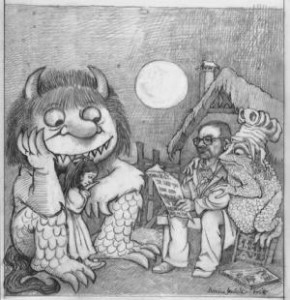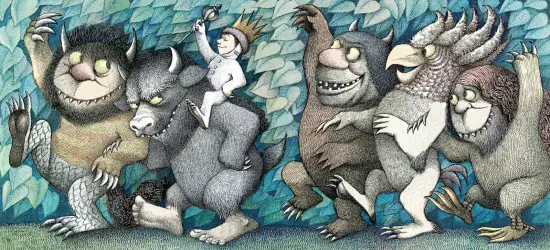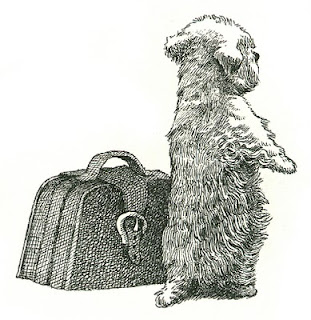by Jas Faulkner
Admitted or not, sometimes trapped deep beneath layers of intellectual noise is the part of us that wants to don a wolf suit and run wild, unfettered by the concerns of real life. The men and women who create those special places are our real life magic makers. Even if we know they are just human beings like the rest of us, we still want them to be something more. After all, they’re the engineers of our childish delight. They provide the inspiration for our many hopes and dreams before waking life and guidance counselors come along to squash them flat. Somehow, this should earn some sort of life pass for those honorary Fairy Godparents of our ids.
Of course it never works out that way.
No matter how inured to the horrors of real life we are, there is that small child inside who is stunned when we find out it was the flu that took the gentle soul that breathed life into Kermit the Frog, stomach cancer that shortened the life of everyone’s favourite neighbor and this morning, a stroke that claimed the wit behind Max’s Wild Rumpus, Jennie’s World Mother Goose Theatre, and Mickey’s forays into the magic that happens when the world goes to bed. What we want for these people is the happily ever after that they provide for us. Anything else just isn’t right.
Who was Maurice Sendak? He was the name on all of those densely rendered books whose anarchic, antic spirit created delightfully naughty adventures sure to cause consternation and hilarity among parents and grandparents. His art and writing were the work of someone who knew the mind and soul of childhood. Growing up as the child of immigrants, growing up as a Jew during the thirties, growing up Gay, he understood how war, social liminalisation, and poverty could affect but never entirely kill the innocent fearlessness of childhood. As grey as adults might make reality, there was the indomitable force of childlike imagination that always prevailed.
delightfully naughty adventures sure to cause consternation and hilarity among parents and grandparents. His art and writing were the work of someone who knew the mind and soul of childhood. Growing up as the child of immigrants, growing up as a Jew during the thirties, growing up Gay, he understood how war, social liminalisation, and poverty could affect but never entirely kill the innocent fearlessness of childhood. As grey as adults might make reality, there was the indomitable force of childlike imagination that always prevailed.
His career was one of contradictions. Critics sometimes found the monsters in “Where the Wild Things Are” as too ugly. Some adults took issue with a naked Mickey running rampant through the dream world of the Night Kitchen. Children had no such problems. They got it. They saw the large-eyed furry beasts as snuggly consorts for the Wild Rumpus and Mickey’s bare penis as a mere detail (and probably far less disconcerting than the smooth, bare mound of a Ken Doll.)
Sendak’s eighty-three years were spent in the care of his extended family at first and then in the arms of his partner of fifty years, Eugene Glynn. His body of work includes collaborations with some of the best writers and artists in children’s literature. His theatrical works include an adaptation of Brundibar alongside playwright Tony Kushner. His interview with Terry Gross in 2011 shows a person still full of wit and possessed of the kind regard he had for the world in spite of its foibles. His contemplation of love, magic, and loss indicated he still had much to say. He wasn’t afraid to poke a little fun at himself or take on the likes of Stephen Colbert, either.
When an artist leaves the world, it is always tempting to wonder if there is some clue to their feelings about death in their work. Sendak addressed the subject in Higgelty Pigglety Pop or There Must Be More To Life. Written as a tribute to his ailing Sealyham Terrier, Jennie, he addresses the ultimate separation as a life transition to be faced like any other adventure. In the book, Jennie feels there has to be more to life than her pampered existence and takes off to explore the world, where she eventually becomes a famous actress. In the end, she sends this letter back to her master:
Hello,
As you probably noticed, I went away forever. I am experienced now and very famous. I am even a star. Everyday I eat a mop, twice on Saturday. It is made of salami and that is my favorite. I get plenty to drink, too, so don’t worry. I can’t tell you how to get to the Castle Yonder because I don’t know where it is. But if you ever come this way, look for me.
Jennie
He was loved by those who knew him and beloved by those of us who grew up with his creative voice as part of our lives. To some, his work is a mere article of childhood ephemera. Now that he is gone, his work will be supplanted by celebrity vanity projects and tie-ins for the latest media/marketing juggernaut as the years he was among us recede into history. For the rest of us, the Wild Rumpus will never be over as long as we can open one of Sendak’s books and fall into that place where the wild things always are.
Alav hashalom.



Hello,
Relay amazing publish nice written and good topic thank you for information 😉
A lovely tribute to a genius Jas. I wrote a thing on the Colbert interview, and it ticked some fans of his off, lol, which is interesting. Colbert showed some more of the interview last night. One of Sendak’s two favorite books, was Higgelty Pigglety Pop and the way he explained the book was hilarious, at least in Colbert’s hands. I remember having his huge Art of Sendak, or some such title, signed by him during a book festival in NYC. It was exciting to meet the man behind 3 Oliver Hardys, and a bunch of Wild Things.
great illustration – the one with the king among monsters!